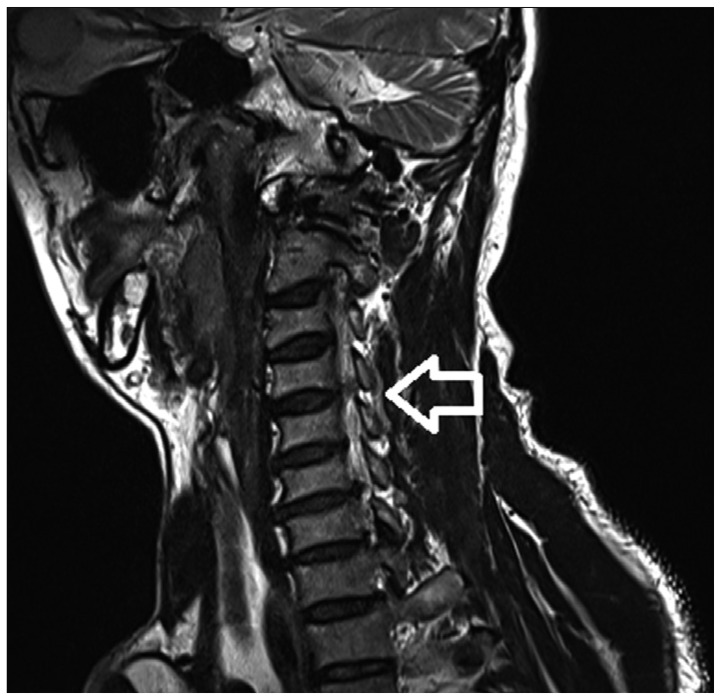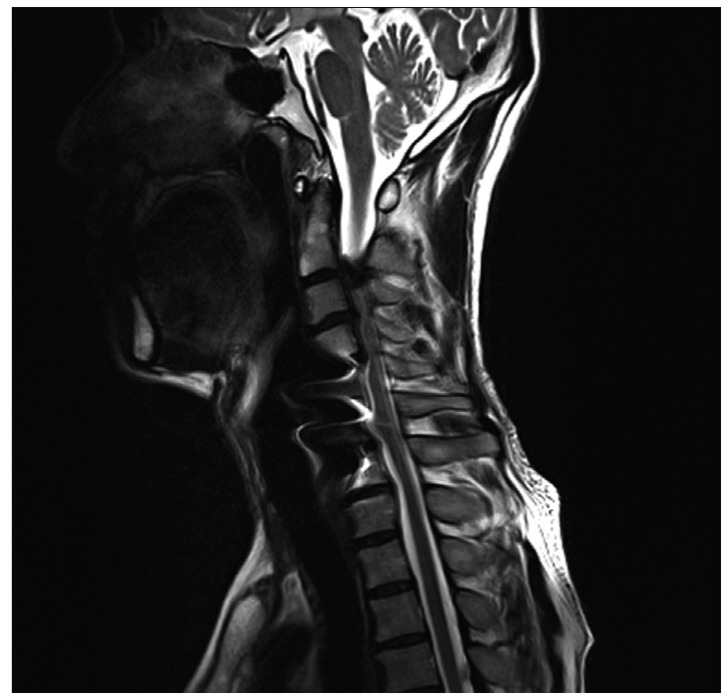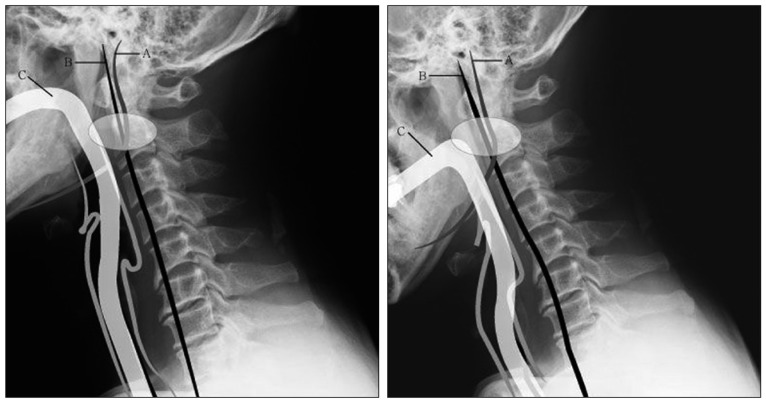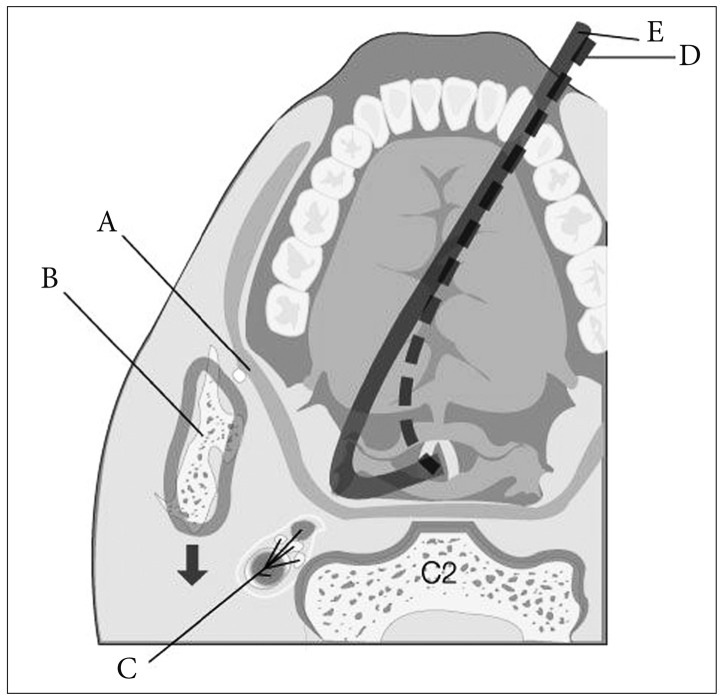J Korean Neurosurg Soc.
2013 Nov;54(5):423-425. 10.3340/jkns.2013.54.5.423.
Tapia's Syndrome after Posterior Cervical Spine Surgery under General Anesthesia
- Affiliations
-
- 1Department of Neurosurgery, The Leon Wiltse Memorial Hospital, Suwon, Korea. surgicel@hanmail.net
- 2Department of Biology, University of California at San Diego, San Diego, CA, USA.
- KMID: 2138360
- DOI: http://doi.org/10.3340/jkns.2013.54.5.423
Abstract
- We present a case report to remind surgeons of this unusual complication that can occur in any surgery, even posterior cervical spine surgery under general anesthesia and discuss its causes, treatment methods, and the follow-up results in the literature. The peripheral Tapia's syndrome is a rare complication of anesthetic airway management. Main symptoms are hoarseness of voice and difficulty of tongue movement. Tapia's syndrome after endotracheal general anesthesia is believed to be due to pressure neuropathy of the vagus nerve and the hypoglossal nerve caused by the endotracheal tube. To our knowledge, no report has been published or given an explanation for Tapia's syndrome after posterior cervical spine surgery. Two patients who underwent posterior cervical surgery complained hoarseness and tongue palsy postoperatively. There is no direct anatomical relation between the operation, the vagus nerves and the hypoglossal nerves, and there is no record of displacement or malposition of the endotracheal tube. After several months, all symptoms are resolved. To avoid this problem in posterior cervical spine surgery, we suggest paying special attention to the position of the endotracheal tube to avoid excessive neck flexion before and during the positioning of the patient.
MeSH Terms
Figure
Reference
-
1. Andrioli G, Rigobello L, Mingrino S, Toso V. Tapia's syndrome caused by a neurofibroma of the hypoglossal and vagus nerves : case report. J Neurosurg. 1980; 52:730–732. PMID: 7373407.
Article2. Boisseau N, Rabarijaona H, Grimaud D, Raucoules-Aimé M. Tapia's syndrome following shoulder surgery. Br J Anaesth. 2002; 88:869–870. PMID: 12173208.
Article3. Boğa I, Aktas S. Treatment, classification, and review of Tapia syndrome. J Craniofac Surg. 2010; 21:278–280. PMID: 20098201.
Article4. de Freitas MR, Nascimento OJ, Chimelli L. Tapia's syndrome caused by Paracoccidioides brasiliensis. J Neurol Sci. 1991; 103:179–181. PMID: 1880535.5. Krasnianski M, Neudecker S, Schlüter A, Krause U, Winterholler M. Central Tapia's syndrome ("matador's disease") caused by metastatic hemangiosarcoma. Neurology. 2003; 61:868–869. PMID: 14504349.
Article6. Lykoudis EG, Seretis K. Tapia's syndrome : an unexpected but real complication of rhinoplasty : case report and literature review. Aesthetic Plast Surg. 2012; 36:557–559. PMID: 22179851.
Article7. Shimohata T, Nakano R, Sato S, Tsuji S. [A patient with aneurysm of extracranial internal carotid artery presenting lower cranial polyneuropathy similar to Tapia's syndrome]. Rinsho Shinkeigaku. 1994; 34:707–711. PMID: 7955729.8. Sotiriou K, Balanika M, Anagnostopoulou S, Gomatos C, Karakitsos D, Saranteas T. Postoperative airway obstruction due to Tapia's syndrome after coronary bypass grafting surgery. Eur J Anaesthesiol. 2007; 24:378–379. PMID: 17087848.
Article9. Tapia AG. Un nouveau syndrome. Quelques cas d'hemiplegie et de la langue avec ou sans paralysie du sterno-cleido-mastoiden et du trapeze. Arch Int Laryng Otol Rhinol. 1906; 22:780–785.10. Tesei F, Poveda LM, Strali W, Tosi L, Magnani G, Farneti G. Unilateral laryngeal and hypoglossal paralysis (Tapia's syndrome) following rhinoplasty in general anaesthesia case report and review of the literature. Acta Otorhinolaryngol Ital. 2006; 26:219–221. PMID: 18236639.
- Full Text Links
- Actions
-
Cited
- CITED
-
- Close
- Share
- Similar articles
-
- Tapia Syndrome after Cervical Spine Surgery
- Tapia's syndrome following cervical laminoplasty: A case report
- A Case of Bilateral Peripheral Tapia's Syndrome Subsequent to Coronary Artery Bypass Graft
- Complications of Anterior and Posterior Cervical Spine Surgery
- Central Retinal Artery Occlusion after Cervical Spine Surgery in Prone Position under General Anesthesia: A case report





